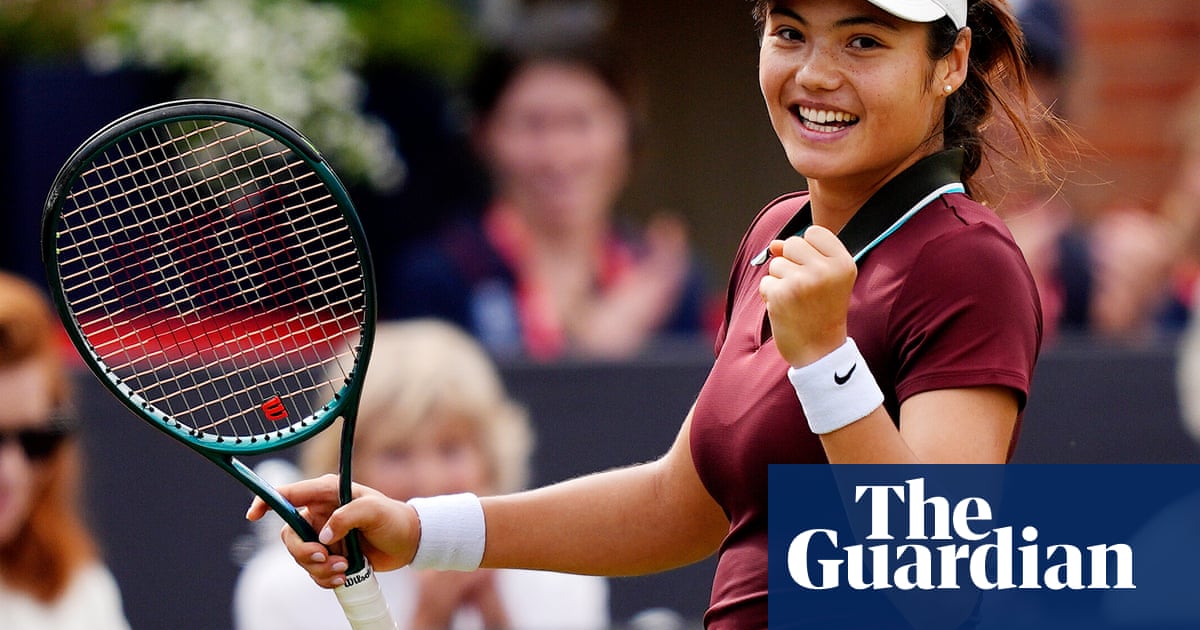Emma Raducanu will regain her status as the best female tennis player in Great Britain for the first time in two years as she continued her solid start to the grass court season by defeating Rebecca Sramkova of Slovakia 6-4, 6-1 to reach the quarter-finals at Queen’s.
Raducanu, who currently sits at No 35 in the live rankings, will return to British No 1 next week afterKatie Boulterfell to the fifth seed Diana Shnaider 2-6, 6-3, 6-2 on Thursday. Raducanu has not been the highest-ranked player in the country since June 2023 when she was recovering from surgeries to her wrists and ankle. She missed a total of eight months in 2023 and consequently fell out of the top 300.
As in her first round win, Raducanu opened the match returning brilliantly, immediately putting Sramkova under constant pressure by taking returns early and looking to dominate the Slovak’s second serve. She flitted to a 5-0 first-set lead but, as she attempted to close out the set, Raducanu lost all momentum and intensity. She was pulled back to 5-4 before resetting and closing out the set with an authoritative service game.
Although Sramkova, the world No 41, is a good player and an excellent athlete, her counterpunching style is better suited to slower surfaces. Here, Raducanu was in total control of most exchanges and, aside from her brief detour in the first set, she was dominant from the baseline. After establishing a 5-1 second-set lead, this time she did not let it slip.
Raducanu is joined this week by both Mark Petchey, who is working with her throughout the grass court season and her previous coach Nick Cavaday. Raducanu and Cavaday had worked together for around 14 months until the end of the Australian Open in January after Cavaday decided to step back due to health reasons. The presence of two trusted voices in her team appears to be another positive step forward for Raducanu.
Before the tournament, Raducanu revealed that her preparation for Queen’s had been disrupted by her continued issues with back spasms, which had affected her days before the French Open at the Strasbourg Open. However, she has looked in good shape throughout the week so far. She started her grass court season with an excellent performance in her dominantwin over the qualifier Cristina Bucșa. She also played two doubles matches with Boulter, her second-ever doubles appearance in her career, a good indication of her physical shape.
Friday will offer a good test of Raducanu’s actual level as she faces a tougher challenge in either Zheng Qinwen, the top seed, or McCartney Kessler, who took the court after her.
Earlier on Thursday, Boulter started her second-round match strongly before being outplayed by Shnaider, a talented left-hander ranked No 12. At 21 years-old, Shnaider is the second-youngest player in the top 20 behind her fellow Russian Mirra Andreeva and she is a devastating ballstriker. “I’m very happy for her to be British No 1,” said Boulter, who will be ranked No 39 at best on Monday. “But at the same time, it’s going to be fun for me to chase her now, and I think she’s been doing that for a while. Now it’s kind of my turn.”
Sign up toThe Recap
The best of our sports journalism from the past seven days and a heads-up on the weekend’s action
after newsletter promotion
After closing out another solid victory and celebrating enthusiastically, Raducanu immediately thought of her doubles partner and friendly singles rival, signing the camera: “Long live Boultercanu.” She later explained that it had been difficult to bounce back after their doubles quarter-final defeat by the top seeds Erin Routliffe and Lyudmyla Kichenok on Wednesday.
“Honestly, it was actually a real challenge for me today,” said Raducanu. “I’m not used to playing doubles. I lost the match yesterday and I was really upset. I really felt I was out of the tournament. So to get myself fired up for this one was really difficult. I’m really happy to get myself through this one. I really want to play with Katie again in the future. Maybe over the grass but for sure in the future.”
